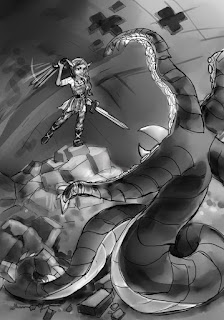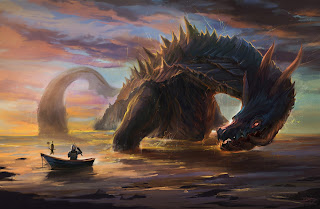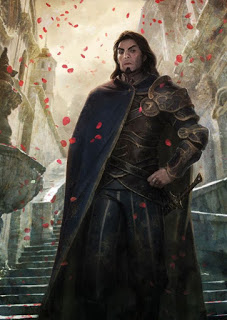 |
| Magic is a heck of a drug |
Well, it turned out to be more of a style guide and player's supplement than a monster manual.
But that got me thinking - can we convert some Magic: The Gathering monsters into D&D monsters? Heck yeah we can!
I know it might be a total surprise to everyone, but once upon a time I was deep into the MtG cult. I had the comprehensive rulebook memorized, I started the MtG Club in middle school, I had these crazy decks that I would test and refine, I even designed my own custom cards. Times sure have changed, huh?
Anyway...
Power/Toughness
The most basic ability that any creature in MtG has is a Power/Toughness score. This is basically offense and defense for the monster. If we're going to transfer these monsters to D&D, we can easily replicate that by adjusting the Offensive and Defensive CR of a monster.
However, there will have to be a bit of an adjustment. See, in D&D, this is a CR 1 Monster:
And in MtG, this is a 1/1 creature:
Additionally, in D&D, a CR 30 monster is considered the top of the game:
But in MtG, the highest you can get is about 13-15:
And even then, the Eldrazi are more unstoppable eldritch nightmares, unlike the Tarrasque, which can be killed by a Wizard with Fly and patience.
So, in the interest of making decent conversions, here's my quick gauge of CR vs P/T.
- P/T 1 = CR 0-1/2
- P/T 2 = CR 1-2
- P/T 3 = CR 3-5
- P/T 4 = CR 6-8
- P/T 5 = CR 9-12
- P/T 6 = CR 13-15
- P/T 7 = CR 16-19
- P/T 8 = CR 20-24
- P/T 9 = CR 25-29
- P/T 10+ = CR 30+
Note that you still have to follow the D&D rules to get the final CR. That means a creature with Offensive CR 8 and Defensive CR 2 will end up with a total CR of 5 (average of 8 and 2). So a 4/2 creature in MtG would be the equivalent of a Wraith (CR 5) in D&D.
Abilities
However, to really get the flavor of the creatures down, we need to copy some abilities from MtG as well. After all, many powerful monsters have low P/T, but see tournament play because of their valuable abilities.
Here are my takes on converting some of the abilities in MtG to D&D. For more detailed descriptions of how different abilities affect CR, check out this series of articles.
- Cumulative Upkeep. At the start of its turn, this creature must succeed on a Constitution saving throw. The DC for this saving throw is equal to 10 + the number of rounds it has existed. On a failure, the creature vanishes to its home plane or dies.
- This would be a good ability to give powerful summoned creatures, like the demons a cultist summons. Most monsters will be able to survive the entire fight (remember, average of 3 rounds) with this, so no CR adjustment is needed.
- For a more interesting twist, give the creature a "Death Burst" effect, similar to a Magmin (MM pg. 212) or Balor (MM pg. 55). This will increase the CR as indicated in the DMG pg. 280. You can decide if the burst happens only if it fails its Upkeep save, or every time it dies. Could be a cool battle!
- Deathtouch. (same as the Life Drain effect of a Wight, MM pg. 300)
- No CR adjustment needed
- For a more intense creature, replace this with an ability like the Banshee's "Wail" (MM pg. 23). Make sure to limit it to once per combat, or only able to target one creature at a time, because this will definitely raise the effective CR of the creature.
- Defender. (just give it no attack actions)
- A creature without attack actions is a rarity. Look to the Shrieker (MM pg. 138) for guidance - these will be low-power creatures. Try to give them roleplaying abilities.
- These creatures might be better as traps that monsters in D&D.
- Double Strike. When this creature is targeted by a melee attack, it can use its reaction to make one melee attack against the creature attacking it. To do so, the creature must be able to see the attacker. This attack is made before the attacker completes their attack.
- Essentially gives an extra attack each round. Also, allows the creature to potentially avoid death by killing their attacker first.
- This will certainly increase the CR of the creature by increasing their average damage output per round.
- Echo. At the end of the first round of combat, this creature must succeed on a DC 15 Constitution saving throw or it vanishes to its home plane or dies.
- Similar to Cumulative Upkeep, this gives players another method of removing a monster from the combat. If they can impose Bane (PHB pg. 216) or Contagion (PHB pg. 227) on the creature, they may only have to deal with it for one round. Remove one round of effective damage from its average.
- Change to a Wisdom save if the monster is trying to keep themselves here by sheer willpower.
- First Strike. When this creature is targeted by a melee attack, it can use its reaction to forsake its turn in combat and make one melee attack against the creature attacking it. To do so, the creature must be able to see the attacker. This attack is made before the attacker completes their attack.
- Similar to Double Strike, but with a greater cost. The creature is banking on avoiding death by killing their attacker first.
- This might decrease the CR of the creature if they normally have a multiattack option.
- Haste. The creature has advantage on their initiative rolls.
- No CR adjustment.
- You could make this very powerful if you went the route of "when this creature rolls initiative, all other creatures gain the surprised condition". giving this creature essentially a free round of attacks. I'd probably use the Quasit's scare ability (MM pg. 63) before I did something like that, though.
- Hexproof/Shroud. (same as Magic Resistance)
- Increases effective AC by 2, as per DMG pg. 280
- You could go for something like the Rakshasa's Limited Magic Immunity (MM pg. 257), but that would make this ability very powerful. To adjust, simply move the spell immunity limit up or down.
- Indestructible. This creature is immune to all damage types.
- I've actually seen some modules that use this sort of ability. It isnt' as broken as it sounds, it just means the PCs are going to have to find some way to restrain, freeze, or knock out the monster. Make sure you give them such options.
- This would effectively make the monster's CR infinite, so it's probably better to think of these monsters as traps than creatures.
- Intimidate. This creature is resistant to damage caused by Elves and Half-Elves, and has advantage on saving throws against effects originating from Elves and Half-Elves.
- Obviously, change the race if you like, or even use a class instead.
- This is kind of a cheap shot at one of your players, so use cautiously. Make sure that player has something else to do in the combat or they will be quite angry with you.
- Landwalk. (same as Tree Stride of a Dryad, MM pg. 121)
- Use different types of terrain. Popping in and out of rocks or snow would make for a fun fight.
- Treat it as teleportation, meaning no CR adjustment.
- Lifelink. Whenever this creature deals damage, it regains hit points equal to the amount of damage dealt.
- This is a major defensive ability. Treat it like Regeneration (DMG pg. 281) and adjust the CR accordingly.
- Phasing. This creature is under the effects of a Blink spell at all times.
- Not much to say here, just assume that the creature will last longer in combat due to their Ethereal Plane jaunts.
- Protection. This creature is immune to damage caused by Elves and Half-Elves, and has advantage on saving throws against effects originating from Elves and Half-Elves.
- Obviously, change the race if you like, or even use a class instead.
- This is kind of a cheap shot at one of your players, so use cautiously. Make sure that player has something else to do in the combat or they will be quite angry with you.
- Shadow. This creature is permanently in the Ethereal Plane. Though it can be seen in the Material Plane, it cannot be interacted with, except by creatures or objects that also exist in the Ethereal Plane.
- No CR adjustment
- Again, we're encouraging non-combat solutions here. Most parties don't have a reliable way to get into the Ethereal Plane, so you may have to provide one as the DM.
- Trample. (same as Ramapge of a Gnoll, MM pg. 163)
- Defeat an opponent, run past them, damage another opponent. Same deal.
- Vigilance. As long as this creature is not incapacitated, it can take a Dodge action as a bonus action.
- Increases the monster's effective AC by 4 for CR calculations
- Basically, the creature can attack and defend in the same round - perfect.
Examples!
Now that we've covered that, let's do an example!
Here's an MtG card:
And here's the D&D stat block:
I used the existing angels in the Monster Manual for inspiration. This guy is tough to kill, but doesn't hit too hard for a CR 15 monster. The real key is finding that chosen creature and killing it instead!
I'm not going to go through the whole process of making a monster, since it's already in the DMG (pg. 274). I encourage you to try it!
Also, I'm not going through Instants, Sorceries, or Artifacts, because those just translate to spells and magic items that are already fairly easy to make. They don't have as much math or calculation that goes into them. Again, look to the DMG (pg 283-285) for guidance!
Thanks for reading!



































